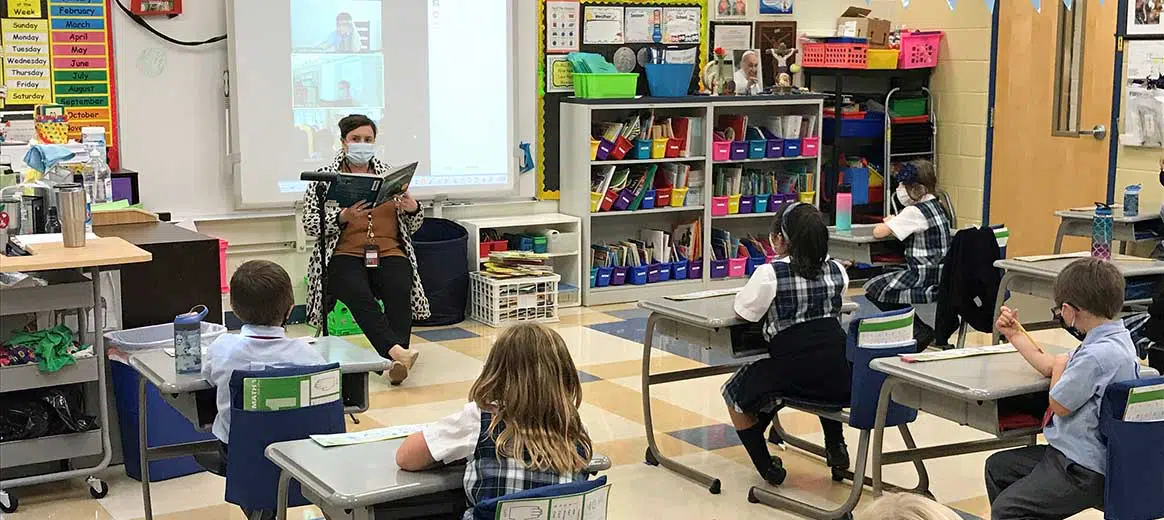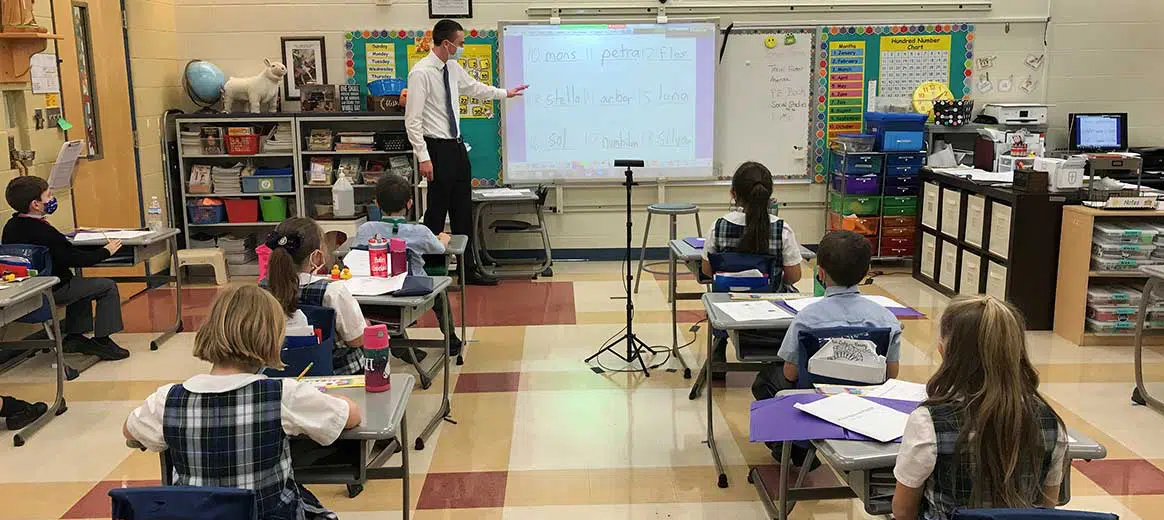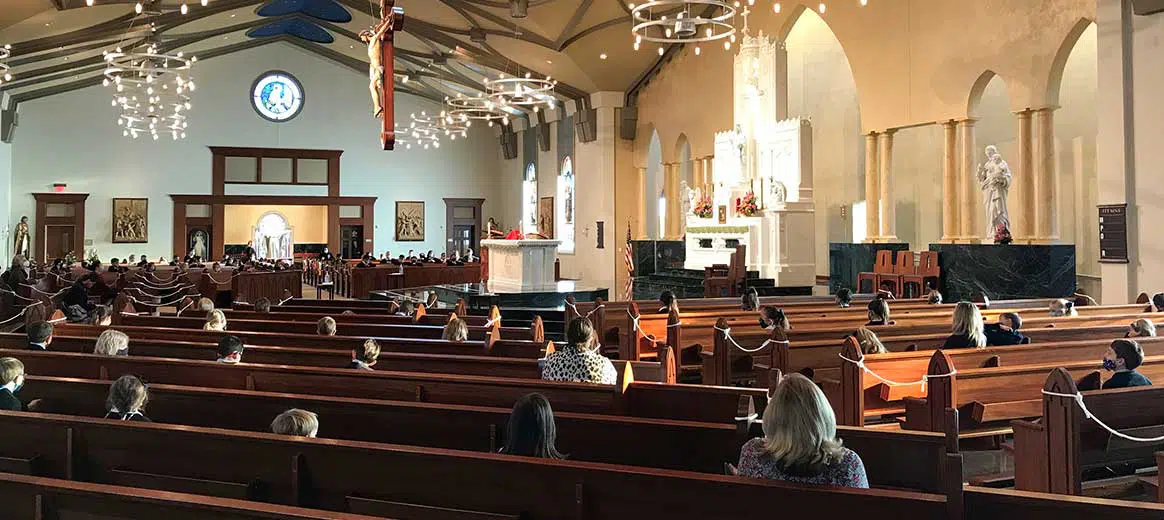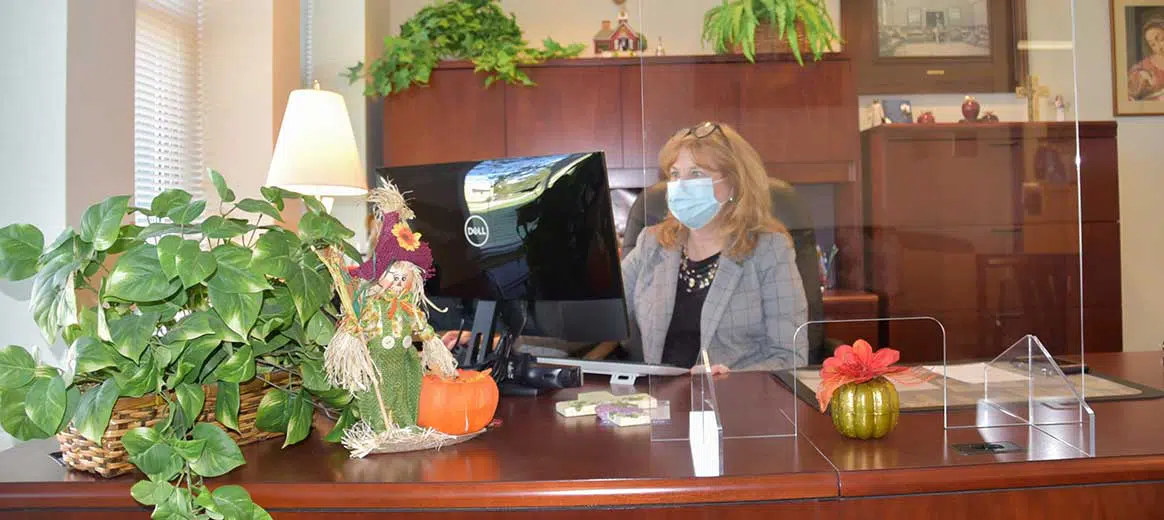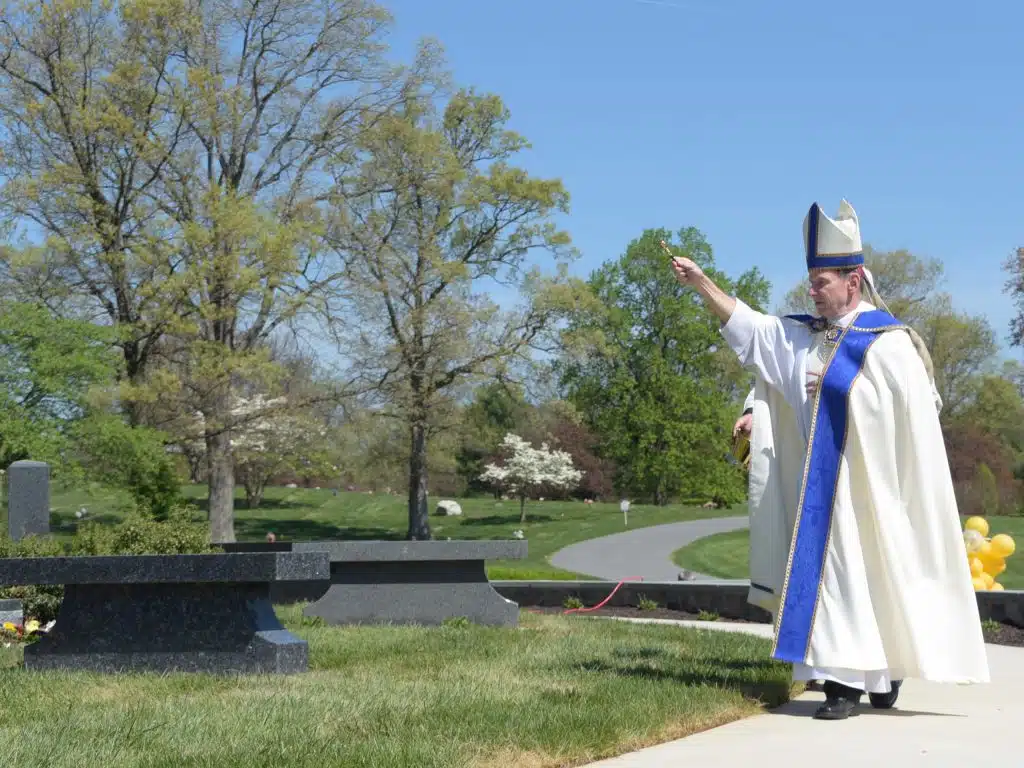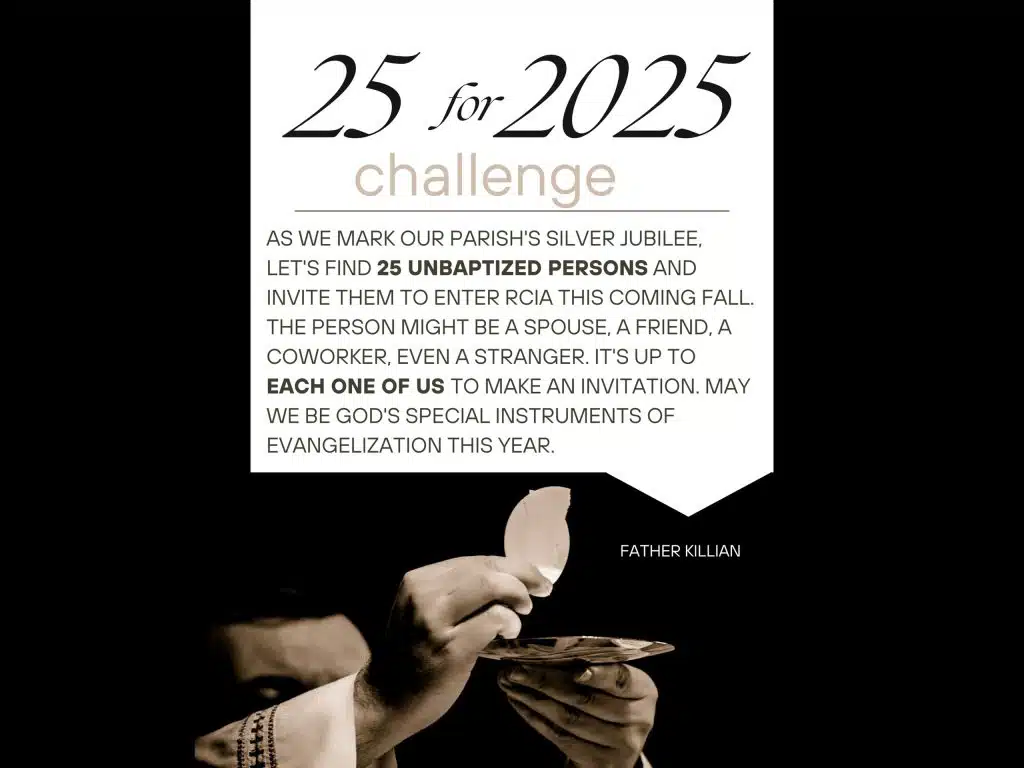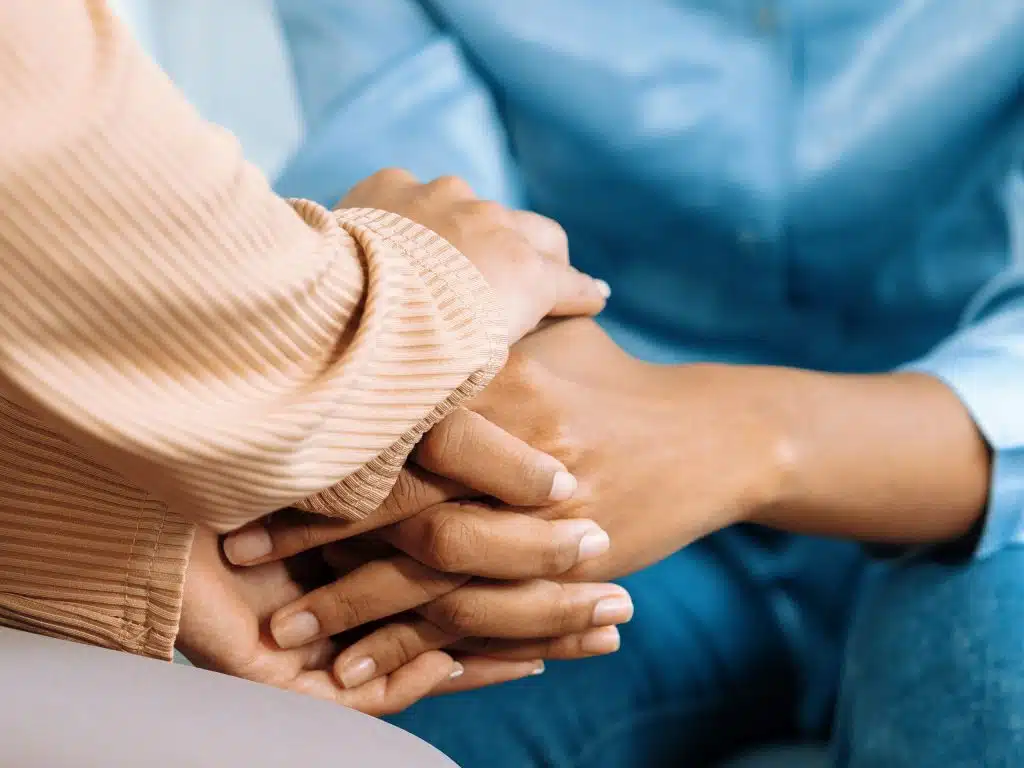When Melissa Marchi pulls up a chair to read to her first graders
at Our Lady of Hope School in Potomac Falls, she can look most of them right in
the eye — but a few are watching through the electronic eye of a tiny new video
camera atop a tall tripod in the front of the room.
“School looks a little bit different, but for students, it’s kind
of a normal school day,” said Principal Mary Beth Pittman, who’s been at the
school since it opened in 2005 and has been principal since 2007. One of the
drivers behind the decision to offer in-person classes this fall — with an
option for at-home learning — was knowing “how important it is for children to
be together with their friends, and to have a regular school routine that was
familiar to them,” she said. “Even if they’re online, they do get to see their
teachers and friends every day.”
“All of our schools have welcomed students back, most in person
all the time, but some with hybrid models,” said Joseph Vorbach, diocesan
superintendent of schools. He said one-third of the diocese’s 37 parish schools
are using some form of a hybrid model; all four diocesan high schools are
hybrid as well.
Our Lady of Hope is the newest elementary school in the diocese,
and with 200 students in kindergarten through eighth grade, it’s also one of
the smallest. But hybrid instruction offers parents maximum flexibility and comfort
in this most unusual pandemic year, Pittman said.
About 10 percent of students are currently remote, she said,
adding that “a couple started at home and then decided to come back in person.”
Class sizes are capped at 24, fewer for kindergarten, to allow social
distancing. Before the pandemic there were 26 or 27 per classroom. Video
cameras were purchased with funding from the Elementary and Secondary School
Education Relief (ESSER) Fund, part of the CARES Act. The school already had
Activboard wall screens.
“After class one day, the camera remained on and one boy was
standing in front of the little camera having a conversation with his friend on
the wall screen, just talking to each other,” Pittman said. “I thought that was
really great to see — they are still part of the class even if they are not
physically here with them.”
SAFETY PROTOCOLS
The school has a long list of safety protocols for in-person
students. Anyone who is not feeling well reports symptoms on a phone app every
morning “to make sure no one is showing up sick,” Pittman said. Temperatures
are taken before they come in the door, and students are grouped in cohorts;
they spend most of the day together in their classroom to limit the number of
contacts. They get breaks for lunch and recess, the only times they don’t wear
masks. Even breaks are supervised to ensure children don’t forget about social
distancing.
“They are respectful of each other’s space, and that has helped
tremendously,” Pittman said. A full-time nurse is on site every day, and a
cleaning crew comes in every evening after everyone has left.
St. Thomas Aquinas Regional School in Woodbridge also follows a
hybrid model, with in-person classes five days a week and an option for at-home
learning; parents of at-home learners pay full tuition in order to save a seat
in the classroom.
“Children are able to return at any point when their family feels
it is safe,” said Sister Mary Sheila Maksim, principal of the school, founded
in 1977 and staffed by the Dominican Sisters of St. Cecilia and a lay faculty.
In a normal year, the school serves about 500 students; this year, class sizes
were capped for social distancing and the student body is just over 400, she
said.
“Of these, less than 20 percent are at-home students and this
number is shrinking every day, with more and more students returning to
school,” she added. “We know that some families are high-risk and have greater
need to stay home, so we are doing our best to include them in our school
family,” with events such as a pumpkin-carving contest and Zoom costume party
Oct. 31 “so that our in-person and at-home learners can all join together to
dance to ‘Monster Mash’ and ‘When the Saints Go Marching In’ and receive
prizes,” she said. At-home learners complete assignments posted online and meet
with an online tutor twice a week. They also meet online with their homeroom
teacher and classmates briefly once a week, “to maintain a healthy social
connection,” she added.
Sister Mary Sheila said she was “pleasantly surprised how well school
is going,” yet knows “we could have a case of COVID at any time — and if so, we
have good plans for one class or the whole school to go virtual. But at this
point, we have not had any cases, and other problems I anticipated have not
come to pass.”
For instance, she said, “I thought that children, especially our
youngest in PK (pre-kindergarten), would have difficulty wearing masks. We
scheduled extra recesses this year for that reason. To my surprise, they seem
to have much less difficulty wearing masks than adults do and sometimes even
wear their masks at recess,” she said, adding that she is proud of how well
students are observing all the health precautions and social distancing. “I am
also grateful to families who have been extra careful and quarantined just in
case.”
Conducting classes in person “has allowed our students to advance
in their studies and to participate in resource and gifted programs in a way
that would not be possible if we were meeting online,” she said, and academic
gaps from online learning last spring are closing. The school was named a
National Blue Ribbon School of Excellence by the Department of Education in
2011.
HAPPY TO BE TOGETHER
“The best thing about being back in school is to see how happy
the children are to be together. Many of them have voiced this to me, and
thanked me for reopening our campus,” Sister Mary Sheila said.
With the extra work of teaching both in-person and at-home
students, both principals say the extra load placed on teachers has been
intense.
“Although we phased in our student body in order to ease into the
year in these stressful circumstances, I underestimated the demands on
teachers,” Sister Mary Sheila said. “Our new precautions meant that they had
almost no time available for collaboration and planning.” They also have been
piloting new learning management software and getting used to working all day
in masks, face shields and other personal protective equipment, she added.
After considering multiple schedule changes that would have posed
even more new challenges, the school decided to dismiss at noon on Wednesdays
to allow teachers time to meet and plan. “This has been a huge relief and
allowed us to regain a healthy balance. I am very grateful to our parents for
their patience with this change, in support of our teachers.”
Pittman agrees. “Teachers work really hard — without them, this
could not be successful.” Between in-class lessons and making sure at-home
learners get the attention they need, “it’s really almost like a double job,”
she said. Our Lady of Hope was named a National Blue Ribbon school in 2015.
Vorbach said he knows “it is no small lift. The planning and
execution of these lessons takes a great deal of thought and time and teachers
are doing it every day. The commitment to mission is present everywhere, along
with great creativity in finding ways to make things work.” He added that some
diocesan schools have “significant waiting lists,” because there are fewer
seats available this year due to social distancing requirements.
At Our Lady of Hope, safety measures extend to a new system of
managing the carpool line at the end of the day. Every family received a large
card with a number to display in a car window; Latin and algebra teacher Shaun
Silk, dubbed “the numbers runner,” keeps track of arrivals and departures.
Children are released from class only when their ride arrives, preventing
clusters of students from gathering outside while waiting in line.
Jennifer Trono of Leesburg, one of the parents lined up in cars
winding through the parking lot on a recent sunny afternoon, said she is happy
with all the precautions the school has taken. Her son, Alexander Kowalczyk, a
kindergartener, “is so happy to be in school,” she said.
“He loves it every day, and he wakes up excited to go to school.
We are very pleased with everything. We made the right choice.”
